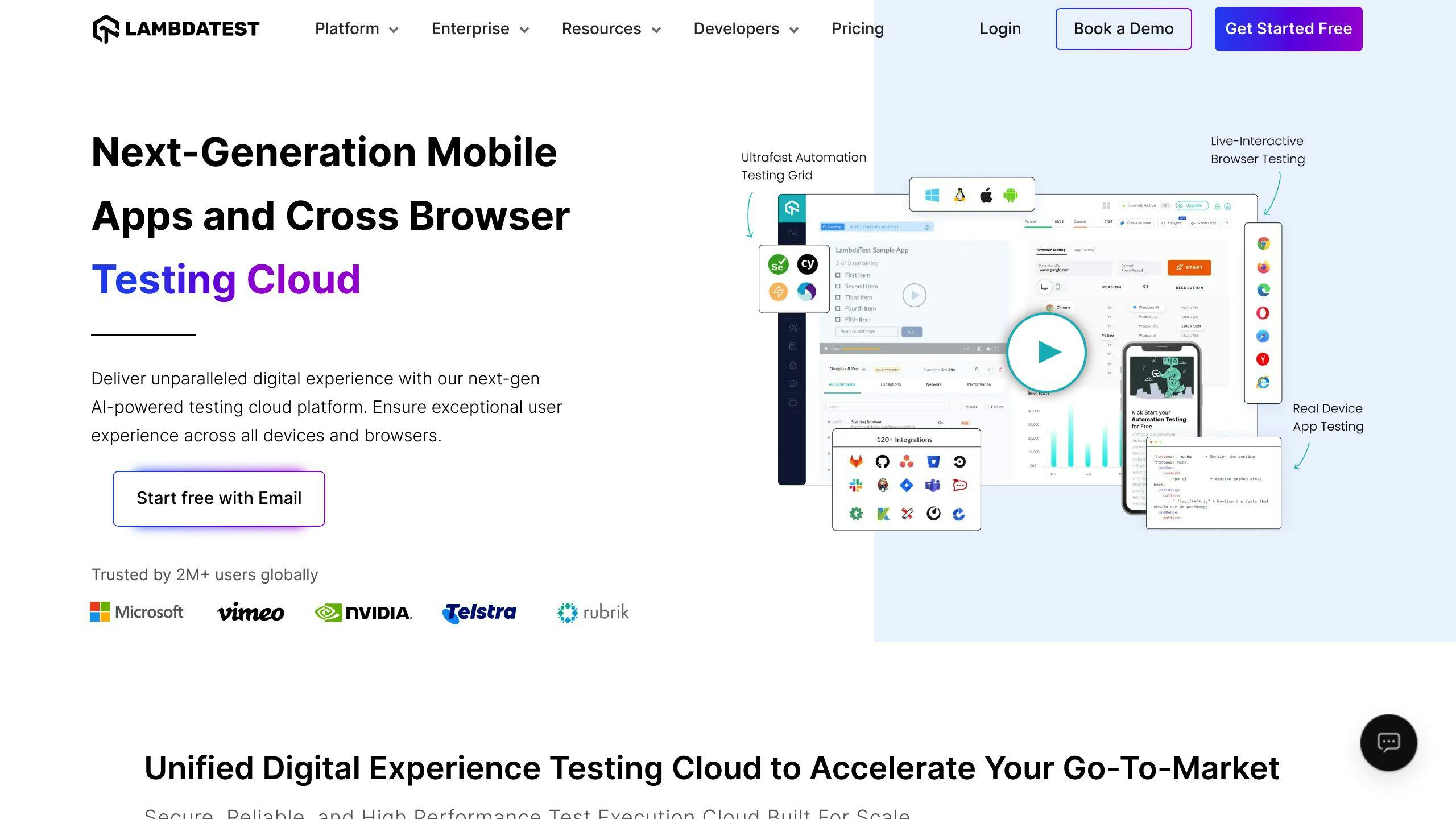AI-powered test analytics is transforming software testing by automating data analysis, spotting patterns, and predicting issues before they happen. It helps teams improve speed, accuracy, and quality in QA processes. Here's what you need to know:
- What It Does: Uses AI and machine learning to analyze testing data, identify patterns, and provide actionable insights.
- Key Benefits:
- 30% faster test execution through prioritization.
- 50% quicker defect detection.
- 20-40% better test coverage.
- 60% fewer false positives.
- Technologies Involved:
- Machine learning for pattern recognition.
- NLP for analyzing test cases and reports.
- Predictive analytics for forecasting defects.
- Real-World Results:
AI-powered tools like TestSigma and IBM Watson are already helping companies save time, reduce errors, and deliver software faster. Ready to learn how to implement it in your workflow? Keep reading for detailed steps, tools, and examples.
LambdaTest Analytics 2.0: AI-Powered Test Analytics And Observability Suite

AI Technologies Used in Test Analytics
Modern test analytics relies on three main AI technologies to improve efficiency and accuracy.
Machine Learning for Spotting Patterns
Machine learning plays a key role in recognizing patterns within test analytics. Here's a breakdown of how different algorithms are applied:
| Algorithm Type | Primary Function | Key Application |
|---|---|---|
| Clustering (K-means, DBSCAN) | Groups similar test cases | Identifying performance bottlenecks |
| Decision Trees/Random Forests | Classifies test outcomes | Predicting test case failures |
| Anomaly Detection | Identifies outliers | Spotting unusual system behavior |
| Neural Networks | Processes complex patterns | Visual regression testing |
For instance, NASA's software testing division showcased how machine learning can enhance quality. By analyzing just 20% of their codebase, they managed to uncover 80% of potential defects [4]. This kind of pattern recognition is the backbone of predictive analytics.
Natural Language Processing for Test Case Analysis
Natural Language Processing (NLP) has transformed how teams manage test documents and analyze requirements. Modern NLP tools can:
- Generate test cases from natural language inputs
- Analyze defect reports for deeper insights
- Establish traceability between requirements and test cases
This technology simplifies handling large volumes of documentation while improving accuracy.
Predictive Analytics for Defect Forecasting
Predictive analytics helps forecast potential issues by leveraging various methods:
- Regression Analysis: Estimates defect likelihood using code metrics.
- Time Series Analysis: Tracks historical patterns to predict future defect trends.
- Machine Learning Classifiers: Pinpoints high-risk code areas.
- Neural Networks: Handles complex relationships in development data.
A real-world example? Siemens' IoT division cut down testing cycles by analyzing 2 million test cases with IBM Watson, echoing Microsoft's success with predictive analytics in Azure DevOps. These tools provide actionable insights that improve testing processes and reduce errors.
These capabilities set the stage for the tool features we'll explore next.
Features of AI-Powered Test Analytics Tools
AI-powered test analytics tools bring three key capabilities to the table, making testing processes faster and more effective.
Automated Reporting and Insights
These tools automatically process vast amounts of test data, turning it into clear, useful insights. They combine data from different testing sources and use advanced visualization and natural language generation to present findings in an understandable way.
| Feature | Benefit |
|---|---|
| Data Aggregation & Context | Offers a unified view with historical insights |
| Pattern Recognition | Identifies potential issues early |
| Visual Analytics | Makes complex data easier to understand |
Smarter Test Case Prioritization
AI tools, like TestSigma, excel at prioritizing test cases. By analyzing factors like defect history, code changes, business importance, execution time, dependencies, and risk, they determine which test cases should be run first. This approach has proven results: TestSigma reduced overall testing time by 40% [3].
This prioritization not only speeds up testing but also lays the groundwork for predicting defects more effectively.
Predicting Defects and Analyzing Root Causes
AI tools can predict defects by analyzing multiple data sources, such as code changes and historical bug data. For example, Microsoft's bug detection system achieves a 99% accuracy rate [4].
When it comes to diagnosing issues, IBM's AIRA tool has been a game-changer, cutting defect diagnosis time by up to 80% [5]. It achieves this by cross-referencing data from:
- Code repositories
- Issue trackers
- Test logs
- Coverage reports
- Performance metrics
- User feedback
These capabilities make AI-powered tools indispensable for modern testing workflows.
sbb-itb-cbd254e
Steps to Implement AI-Powered Test Analytics
Setting up AI-powered test analytics involves thoughtful planning and execution to ensure it fits seamlessly into your testing process. Below are the key steps to guide you through the integration.
Selecting AI Testing Tools
Picking the right AI testing tool is a game-changer for your testing strategy. Look for tools that meet your organization's specific needs and are compatible with your current systems.
| Selection Criteria | What to Look For |
|---|---|
| Integration | Works smoothly with your existing tools and frameworks |
| Scalability | Can manage increasing volumes of test data |
| Security | Meets SOC 2 standards and includes strong data encryption |
| Support | Includes clear documentation and responsive vendor assistance |
| Cost | Covers license fees, setup costs, and expected return on investment |
Once you've chosen the tools, the next step is to ensure your data is ready for analysis.
Preparing Data for AI Analysis
High-quality data is the backbone of effective AI analytics. Begin by auditing your current test data and addressing these crucial areas:
- Data Cleaning: Spend 2–3 weeks removing duplicates, fixing errors, and standardizing formats. Clean data ensures accurate AI insights.
- Data Labeling: Organize and label your data for training AI models. This includes tagging defects, test outcomes, and scenarios. A clear, consistent labeling system helps teams stay aligned.
- Data Security: Apply strong security measures to protect your QA data. Ensure compliance with SOC 2 standards to safeguard sensitive information.
Integrating AI Analytics into Workflows
Integrating AI analytics successfully requires a phased approach:
- Planning (2–4 weeks): Identify the metrics you’ll track and determine where AI fits into your workflow.
- Pilot (4–6 weeks): Test the system on a smaller scale, gather feedback, and make adjustments.
- Scale-Up (8–12 weeks): Roll out AI analytics across teams and integrate it into your CI/CD pipelines.
Automate data flow between your testing tools and the AI analytics platform. Define clear triggers for when AI analysis should run, such as post-build or before major releases. This ensures the process stays streamlined and efficient.
Examples of AI-Powered Test Analytics in Use
Boosting Testing Efficiency with AI
Big names like Spotify and Airbnb have made impressive strides in testing efficiency. Spotify managed to cut test execution time by 50%, while Airbnb slashed regression testing time by 70%, all thanks to AI-driven prioritization [7][2]. Netflix also joined the ranks, using a failure prediction system to trim testing time by 40% through smarter resource allocation [1].
Enhancing Software Quality with AI
Microsoft's AI-powered bug prediction system has delivered standout results:
- Defect Detection Rate: Increased by over 90%
- False Positives: Reduced by 60%
- Time to Resolution: Shortened by 45%
Similarly, IBM's AI-based code analysis tool has shown its strength by improving defect detection accuracy by 80% and cutting manual review time in half [8].
Key Lessons from Early Adopters
Organizations that have embraced AI analytics offer some valuable insights:
- Data Quality is Critical: AI models rely heavily on clean, reliable data. Investing in robust data collection and preparation processes is a must before rolling out AI analytics [4].
- Collaboration is Key: Bringing QA teams, developers, and data scientists together ensures smooth implementation and better interpretation of AI-generated insights [6].
- Start Small and Scale: The most effective strategies involve starting with targeted test scenarios and expanding gradually as results prove successful [5].
These examples highlight how AI-powered analytics are transforming testing processes, delivering measurable results, and providing actionable insights for enterprises.
Conclusion: The Impact of AI on Test Analytics
AI-powered test analytics is changing the game for QA practices. By 2025, it's expected that half of large enterprises will adopt AI-augmented testing, leading to a 30% improvement in software quality [9]. Earlier case studies highlight this shift, with Deloitte's research showing a 22% boost in customer satisfaction and a 19% drop in development costs.
This shift isn't just about numbers - it’s also redefining QA roles. According to a Capgemini survey, 86% of QA professionals see AI as a tool that enhances their work, not replaces it. With AI taking over routine analysis, QA teams can now zero in on strategic tasks and tackle more complex testing challenges.
The adoption of AI in test analytics is only gaining momentum. Gartner forecasts that by 2025, 70% of enterprises will use AI-augmented testing - a huge leap from just 5% in 2021 [9].
As testing becomes more intricate, AI-powered analytics will be key to maintaining the balance between speed and quality in software development.



